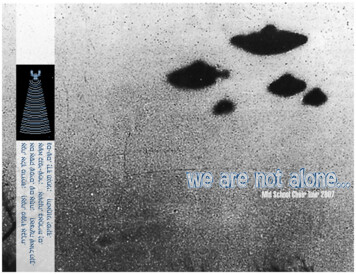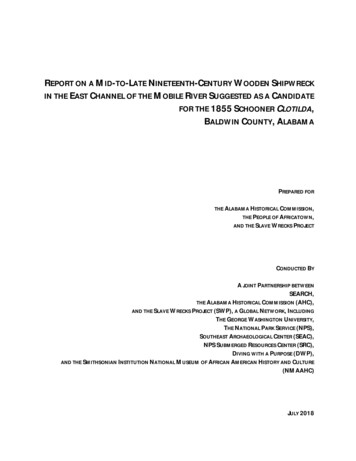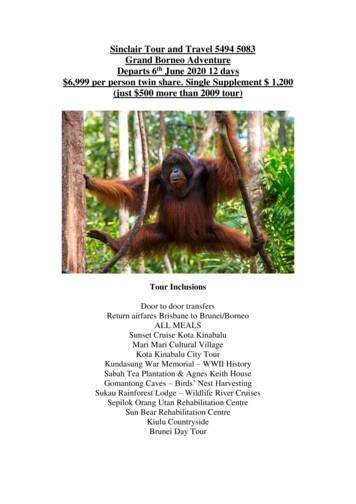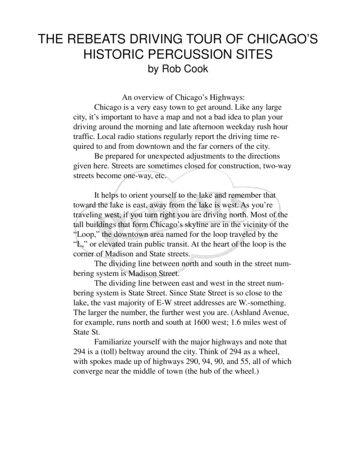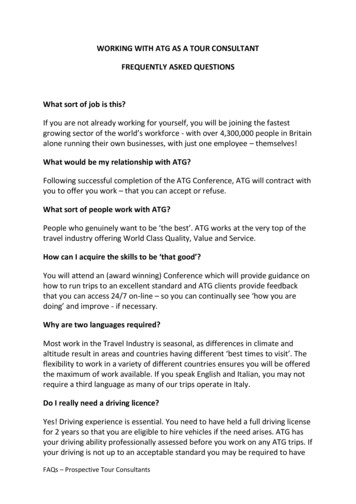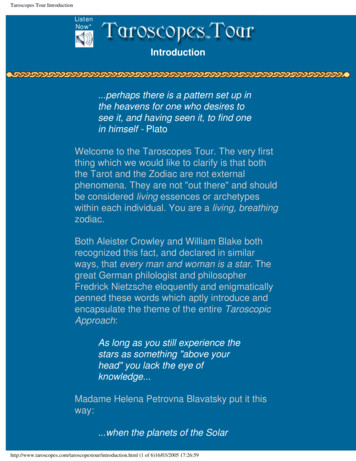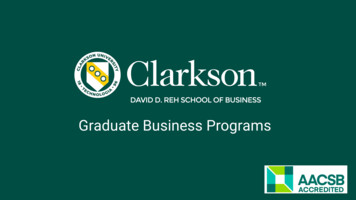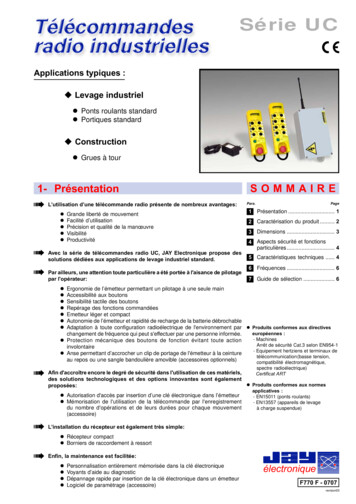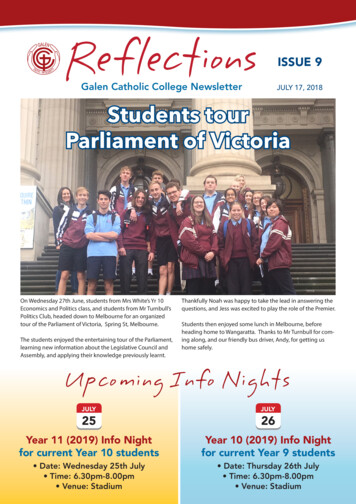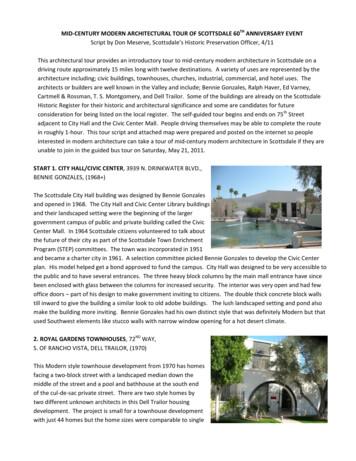
Transcription
MID‐CENTURY MODERN ARCHITECTURAL TOUR OF SCOTTSDALE 60TH ANNIVERSARY EVENTScript by Don Meserve, Scottsdale’s Historic Preservation Officer, 4/11This architectural tour provides an introductory tour to mid‐century modern architecture in Scottsdale on adriving route approximately 15 miles long with twelve destinations. A variety of uses are represented by thearchitecture including; civic buildings, townhouses, churches, industrial, commercial, and hotel uses. Thearchitects or builders are well known in the Valley and include; Bennie Gonzales, Ralph Haver, Ed Varney,Cartmell & Rossman, T. S. Montgomery, and Dell Trailor. Some of the buildings are already on the ScottsdaleHistoric Register for their historic and architectural significance and some are candidates for futureconsideration for being listed on the local register. The self‐guided tour begins and ends on 75th Streetadjacent to City Hall and the Civic Center Mall. People driving themselves may be able to complete the routein roughly 1‐hour. This tour script and attached map were prepared and posted on the internet so peopleinterested in modern architecture can take a tour of mid‐century modern architecture in Scottsdale if they areunable to join in the guided bus tour on Saturday, May 21, 2011.START 1. CITY HALL/CIVIC CENTER, 3939 N. DRINKWATER BLVD.,BENNIE GONZALES, (1968 )The Scottsdale City Hall building was designed by Bennie Gonzalesand opened in 1968. The City Hall and Civic Center Library buildingsand their landscaped setting were the beginning of the largergovernment campus of public and private building called the CivicCenter Mall. In 1964 Scottsdale citizens volunteered to talk aboutthe future of their city as part of the Scottsdale Town EnrichmentProgram (STEP) committees. The town was incorporated in 1951and became a charter city in 1961. A selection committee picked Bennie Gonzales to develop the Civic Centerplan. His model helped get a bond approved to fund the campus. City Hall was designed to be very accessible tothe public and to have several entrances. The three heavy block columns by the main mall entrance have sincebeen enclosed with glass between the columns for increased security. The interior was very open and had fewoffice doors – part of his design to make government inviting to citizens. The double thick concrete block wallstill inward to give the building a similar look to old adobe buildings. The lush landscaped setting and pond alsomake the building more inviting. Bennie Gonzales had his own distinct style that was definitely Modern but thatused Southwest elements like stucco walls with narrow window opening for a hot desert climate.2. ROYAL GARDENS TOWNHOUSES, 72ND WAY,S. OF RANCHO VISTA, DELL TRAILOR, (1970)This Modern style townhouse development from 1970 has homesfacing a two‐block street with a landscaped median down themiddle of the street and a pool and bathhouse at the south endof the cul‐de‐sac private street. There are two style homes bytwo different unknown architects in this Dell Trailor housingdevelopment. The project is small for a townhouse developmentwith just 44 homes but the home sizes were comparable to single
family detached homes of the period – about 2000 square feet average. Parking for residents is in the rear ofthe homes off alleys. The Historic Preservation Commission considers the project an excellent candidate forlocal register designation due to its outstanding design, architecture and layout. The scalloped concrete roofover the bathhouse or clubhouse illustrates how architects were experimenting with thin‐shelled concrete formsin the 60s. Dell Trailor built several townhouse developments in Scottsdale and the Valley. The lamps on theentry walls were also used at other Dell Trailor projects.3. VILLA MONTEREY, TOWNHOUSES, MILLER & CHAPARRAL RDSDAVE FRIEDMAN, PENDING LOCAL REGISTER LISTING (1961 )The Villa Monterey “Casita Colony” was a very large age‐restricted townhouse development by Dave Friedman and hisButler Homes company in the 1960s, one of the first largetownhouse developments in the Valley. Unlike many projectsby other developers at the time, he borrowed elements fromseveral older styles for the facades of the homes to give buyera variety of styles to choose from. The homes used architecturalelements of several period revival styles including Spanish Colonial, Territorial, Mission, Monterey,Mediterranean, and Pueblo. Ornamental ironwork is seen in early and later plats but is more prevalent in laterunits along Chaparral Road. Decorative concrete blocks were also used for at the top of parapets and forapplied reliefs. Friedman made sure buyers knew he was selling townhomes on their own lots and NOTcondominiums. Each Unit had their own community pool, clubhouse, ramada and other amenities. Units 1‐7are proposed to be designated on the Scottsdale Historic Register as a historic district. The one‐ and two‐storyhomes use a variety of simple details to differentiate each home. By 1975 one out of every four homes inScottsdale was a townhouse. The percentage of townhouses today is lower.4. GLASS AND GARDEN COMMUNITY DRIVE‐IN CHURCH,8620 N. MCDONALD DRIVE, E. LOGAN CAMPBELL (1966)This church by E. Logan Campbell was a definite departure indesign and concept from other places of worship. For one itwas a drive‐in church with speakers on posts like a drive‐intheatre in the eastern parking lot. People could observe theservice through the large glass wall on the eastern façade.The architect was not satisfied with a plain concrete cylinderor dome, but felt compelled to add more southwesterndetails to the structure including sculptural columns withgreen aggregate, ornamental ironwork on the cross tower over the dome and an ornamental freize/border ofcolored sculptured concrete along the top of the cylinder – what Robert Venturi would probably call a decoratedcylinder and dome. Venturi liked to describe architecture as a box or a decorated box. Like the City Hall andLibrary buildings by Bennie Gonzales a couple of years later, this building is Modern with southwestern detailsadded to the structure, a style referred to locally as Southwest Modern.
5. ST. MARIA GORETTI CATHOLIC CHURCH, 6261 N. GRANITE REEFROSSMAN ASSOC , ARCHITECT, JOHN PARSONS, ENGINEER (1967)Unlike the nearby Glass and Garden Community Church, this thin‐shelledconcrete building lets the shape of the building speak for itself withoutmuch ornamentation. This very sculptural style is often calledExpressionist by academics or architectural critics. The 60 foot hyperbolicarched roof resembles two intersecting saddles with a dome on top. Thissculptural concrete style is related to the work of a Spanish architect, FelixCandela who built several thin‐shelled concrete churches in Mexico in the1950s using curving or hyperbolic forms. Scottsdale and Valley churchesfrom the ‘50s and ‘60s demonstrate an acceptance of new styles of buildingand provided opportunities for architects to express their concepts ofsacred space for worship using a variety of construction techniques.Expressionist architecture was often the result of a collaboration between an innovative architect and engineer.The same architect and engineering firms were responsible for the thin‐shelled concrete Los Arcos MethodistChurch south of McDowell Road.6. MOTOROLA GOVERNMENT ELECTRONICS DIVISION,8201 E. MCDOWELL RD, VARNEY, SEXTON, SYDNOR ASSOC (1957)TOWER ADDITION BY PETER LENDROM ASSOC (1970)When the Motorola electronics plant opened along McDowellRoad in 1957 it stimulated new residential development in thisarea of Scottsdale and Motorola contributed to a high growthrate in Scottsdale’s population in the post WW II era. The Valleyhad other defense or government related industrial plantsduring and after the war. The long low building with a tower feature is reminiscent of the “Garden Industrial”style buildings in the east surrounded by landscaped lawns. It gives the appearance of a ‘clean’ manufacturingplant as opposed to older steel mills or ‘dirty’ industries. The grass lawn along McDowell Road has recently beenreplaced with desert landscaping, taking away visually from the broad lawn in front of a long horizontal building.The decidedly Modern building by Edward L. Varney Associates with no applied ornamentation has anInternational feel like the more vertical steel and glass skyscrapers and the work of architect Mies van der Rohe.The 1970 tower addition by Peter Lendrom departs from the flat steel, glass and aluminum panels in order tohave some added depth to the buildings skin. The original 1970 building is the best example of an intact GardenIndustrial building in Scottsdale if not the state.7. VALLEY NATIONAL BANK (CHASE), 7345 E. MCDOWELL RDCARTMELL & ROSSMAN (1962)This branch bank building looks a bit lonely at 74th and McDowell Roadtoday but the diagonal concrete struts holding up the broad overhangingroof would have surely have attracted the attention of passing motoristswhen it opened in 1962. Walter Bimson of Valley National Bank liked touse prominent local architectural firms for his bank branches around the
Valley. Like other projects by Cartwell and Rossman architects, the structure of the building form is emphasized.Other Valley National Banks by prominent firms around the Valley are also worth preserving and beingrecognized for their unique designs. The style of this Modern building is difficult to classify as a sub‐style but itcan be related to Expressionist style buildings for the dominant diagonal struts that make the primary facadelook a bit like a snare drum.8. TOWN AND COUNTRY SCOTTSDALE, 74TH/OAK, RALPH HAVERLISTED ON LOCAL, STATE AND NATIONAL REGISTERS (1958 )Like other Valley neighborhoods with homes designed by RalphHaver, this gem by Coronado High School of 62 homes by WoodyWoodworth is getting the attention the home designs deserve.Using four house plans, the subdivision has varied materials forwalls to provide a semi‐custom appearance for modest sizehomes with a Contemporary style. The irregular ‘Klinker’ brickson some of the facades make for an interesting front façade. The low pitched gable roofs with the ends facingthe street and tall walls of window are often a feature of Ralph Haver designed homes. The Modern style of thehomes was a departure from the predominant Ranch styles house being built in Scottsdale in the ‘50s. Theneighborhood is now listed on the National Register and many homes have retained their original features.9. FIRST CHURCH OF CHRIST SCIENTIST,6427 E. INDIAN SCHOOL ROAD, T. S. MONTGOMERY (1962)The architect uses a screen wall of concrete blocks on the northfaçade of the sanctuary and along the side of the building,reminiscent of screen walls used by architect Edward Durrell Stonein several buildings during this time period. T. S. Montgomery usedcopper with raised seams for the fascia and tower, and he usedburnt adobe bricks for the solid walls. This Modern style architecturefeatures local materials from the southwest and Arizona like copperand burnt adobe bricks. The gate on the driveway is often closed sothe bus tour will not stop at the church but a car could park betweenthe street and the closed gate. Doug Sydnor featured this church inhis book on Scottsdale Architecture and said: “The structureepitomizes an innate understanding of an appropriate scale, which isaccomplished with natural materials and great skill.” It seems thatarchitects appreciate the design of this understated modest sizedchurch more than the general public.10. HOTEL VALLEY HO, 6850 E. MAIN ST, ED VARNEY,LISTED ON SCOTTSDALE HISTORIC REGISTER (1956/1958)Fortunately this declining historic hotel was bought from the prior owners by Westroc. Keenly interested inrehabilitating the three historic hotel buildings by Edward L. Varney, they added some new construction to makethe project financially viable. The original design contemplated having a multi‐story tower built as an additionover the lobby and restaurant areas – the foundations and support columns were designed and constructed to
be oversized to accommodate this future tower addition. How‐ever instead of building the tower, the hotel owners added thetwo separate two‐story guest room buildings in 1958 towardsIndian School Road. The city placed the Hotel Valley Ho on itslocal register when it was for sale and fortunately the buyerwanted to save the building designed by Ed Varney. Like otherModern buildings of this period in the Valley, the architecture alsoadded ornamental elements of the pre‐cast sculptural railings andcladding for the columns in the lobby area. The long two‐storyhotel wings emphasize the horizontal lines with an added tower feature by the entrance, similar to the GardenIndustrial forms of Motorola by the same architectural firm. Each guest room had floor to ceiling windows andarcadia doors with screens between the patios or balconies of each unit. The new owner and architects addedthe tower element, a health club and spa, meetings rooms, a new 2‐story guest room and brought the TraderVic’s restaurant to Scottsdale. A similar vintage hotel in Scottsdale by Al Beatle called the Safari Hotel wasdemolished.11. CRAFTSMAN COURT, 7121‐7141 E. 5th AVENUE,T. S. MONTGOMERY, LISTED ON SCOTTSDALE HISTORIC REGISTER (1955)This seven building retail complex on 5th Avenue was designed by T. S.Montgomery, the same architect as the one for First Church of Christ, Scientist.Craftsman Court, now called Kiva Centre, is associated with Scottsdale'sdevelopment as an arts colony and tourist destination. A number of prominentartists were associated with this arts center when it opened such as Lloyd KivaNew, who was a champion for the emerging Indian crafts movement in postwarScottsdale and nationwide. The Modern architectural design of the complexblends with the desert landscape and uses a dignified western design motifadopted by downtown businesses in the fifties for marketing “The West’s MostWestern Town”. The stores have low‐pitched gable roofs and floor to ceilingglass walls like other Modern buildings of the period. The large panels of stained glass in the rear building onthe courtyard have been removed but the original tile panels remain. Craftsman Court is on the local register.12. TRIANGLE BUILDING, 7120 E. INDIAN SCHOOL ROAD,RALPH HAVER (1962)This two‐story commercial building is included on this tourbecause the city leased the building for city offices beforethe City Hall was built. It is also a Ralph Haver design withhis signature low‐pitched gable roof with the gable endfacing the street. Glass globe lights are a very ‘60s featureof the design along with the large expanses of glass and ablock screen wall by the stairs. The Modern design is fairlysimple but elegant. Fortunately the property has not been the target for redevelopment –yet. I encourage youto compare the design and materials for this building to the earlier 1953 Pima Plaza building on 1st Avenue andBrown by the same architect, Ralph Haver. In keeping with the Western theme for the Old Town commercialdistrict he used different materials like board‐and‐batten siding on the 1st Avenue building.
Butler Homes company in the 1960s, one of the first large townhouse developments in the Valley. Unlike many projects by other developers at the time, he borrowed elements from several older styles for the facades of th
